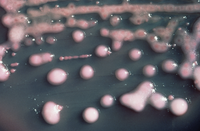
Photo from wikipedia
Wastewater treatment plants (WWTPs) are considered to be a reservoir and a source of bacterial resistance. Worryingly, the presence of carbapenem-resistant Gram-negative bacilli (CRGNB) in WWTPs has recently been reported,… Click to show full abstract
Wastewater treatment plants (WWTPs) are considered to be a reservoir and a source of bacterial resistance. Worryingly, the presence of carbapenem-resistant Gram-negative bacilli (CRGNB) in WWTPs has recently been reported, but there are still many research gaps regarding its emergence and impact. The distribution of CRGNB in the different stages of a WWTP in Colombia and the relationship between the physicochemical factors involved with their presence are described in this paper. Additionally, given the impact on public health, the CRGNB detected were compared with isolates previously found in hospital patients. Residual water samples were taken from five different stages of a WWTP between January and July 2017. A total of 390 GNB were isolated, and a significant frequency of CRGNB harboring blaKPC-2 (38.2%, n = 149/390) was detected, of which 57% were Enterobacteriaceae, 41.6% Aeromonadaceae, and 1.3% Pseudomonadaceae. The Enterobacteriaceae were more frequent in the raw effluent compared to the Aeromonadaceae, which in turn were more prevalent in the recycled activated sludge and final effluent. Environmental variables such as pH, oxygen, chemical oxygen demand, and temperature were significantly correlated with the quantification of carbapenem-resistant Enterobacteriaceae (CRE) at specific points in the WWTP. Interestingly, isolated K. pneumoniae harboring blaKPC-2 from the WWTPs were diverse and did not relate genetically to the hospital strains with which they were compared. In conclusion, these results confirm the worrying scenario of the dissemination and persistence of emerging contaminants such as CRGNB harboring blaKPC-2, and reinforce the need to establish strategies aimed at containing this problem using multifocal interventions.
Journal Title: Journal of environmental management
Year Published: 2020
Link to full text (if available)
Share on Social Media: Sign Up to like & get
recommendations!